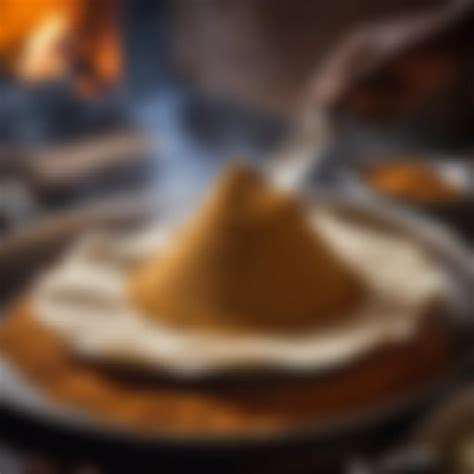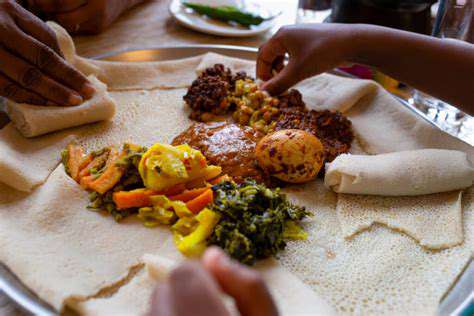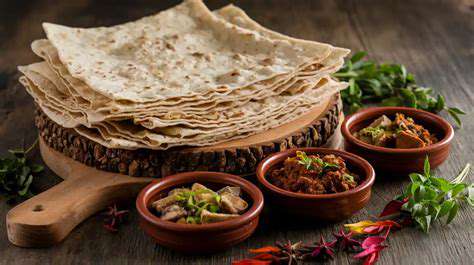Discovering Ethiopian Injera: The Ultimate Guide

A Deep Dive into the Ingredients
Injera, Ethiopia's iconic spongy flatbread, stands as a shining example of culinary craftsmanship passed down through generations. What truly sets it apart is the teff flour - this ancient grain isn't just an ingredient, but the soul of the bread, giving it that distinctive texture and earthy flavor. Preparing the starter mixture feels almost magical - watching simple flour and water transform through days of fermentation into a bubbling, living culture. The sour aroma that develops tells you it's working, those tiny microorganisms creating the complex flavors that make injera special.
Getting the ingredients just right requires an artisan's touch. The water must be at that perfect temperature - not too hot to kill the culture, not too cold to slow it down. Salt gets added with careful precision; too little and the flavors fall flat, too much and the fermentation suffers. Many Ethiopian cooks swear by using the same clay pot year after year, believing it contributes to the depth of flavor. This attention to detail shows how what might seem like simple ingredients actually require deep understanding to work their magic.
The Art of Shaping and Cooking
Watching an experienced injera maker at work is like observing a painter creating art. The dough gets poured onto the mitad (clay griddle) in a perfect spiral motion, starting from the outside and working in. This technique, perfected over years of practice, creates those signature honeycomb bubbles that make injera unique. The cook's wrist flicks just right to spread the batter to an even thinness - about 3 millimeters is ideal. Too thick and it becomes doughy, too thin and it might tear.
The cooking process requires constant attention. The clay griddle must be heated to exactly the right temperature - you can tell it's ready when a drop of water sizzles and evaporates immediately. As the injera cooks, the cook watches for the telltale signs: first the edges start to curl slightly, then the surface becomes dotted with those perfect steam holes. The timing is crucial - about 2-3 minutes per side. Pull it off too soon and it's gummy; leave it too long and it loses that perfect spongy texture. When done right, you get that perfect combination of slightly crisp bottom and soft, porous top that makes injera so delightful to eat.
Beyond the Plate: Injera's Role in Ethiopian Culture

Injera's Cultural Significance
In Ethiopian homes, making injera often becomes a family affair, with knowledge passed from mother to daughter over generations. This shared activity strengthens bonds while preserving traditions that date back centuries. During holidays and special occasions, the kitchen fills with laughter and stories as multiple generations work together preparing large batches. The rhythmic sound of dough being poured onto griddles becomes the background music of family gatherings.
In restaurants and homes alike, serving food on a large platter of injera symbolizes more than just practicality. The circular shape represents unity and equality - everyone eats from the same plate, tearing off pieces to scoop up the shared dishes. This tradition reflects core Ethiopian values of community and togetherness. Even the way the injera gets folded - carefully arranged with the best side facing up - shows respect for guests and the meal itself.
Nutritional Value and Health Benefits
Modern nutrition science has confirmed what Ethiopian cooks have known intuitively - injera offers remarkable health benefits. The lengthy fermentation creates beneficial probiotics that support gut health. Unlike many breads that spike blood sugar, injera's complex carbohydrates provide steady energy. For those with gluten sensitivities, traditional teff-based injera offers a nutritious alternative to wheat breads while providing complete protein and essential minerals like iron and calcium.
What's particularly fascinating is how the traditional preparation enhances nutritional value. The fermentation process increases vitamin B content and makes minerals more bioavailable. Some studies suggest the lactic acid bacteria produced during fermentation may even boost immunity. This combination of ancient wisdom and modern nutritional benefits makes injera uniquely valuable in today's health-conscious world.
Preparation and Culinary Applications
The process of making injera varies slightly from region to region, with each area developing its own subtle variations. Some prefer a longer fermentation for more sourness, others add a bit of barley flour for different texture. The beauty lies in this diversity - no two injeras are exactly alike, each bearing the mark of its maker. This flexibility allows for endless culinary creativity while maintaining the bread's essential character.
Beyond its traditional use as an edible plate, innovative chefs have found new applications. Some use injera as wraps for sandwiches, others bake it into chips for dipping. Ethiopian fusion restaurants might serve injera tacos or use it as pizza crust. Yet no matter how it's adapted, the soul of injera remains - that distinctive porous texture and slightly tangy flavor that make it so special.
Injera's Impact on the Economy
Walk through any Ethiopian market and you'll see the economic importance of injera. Women balance stacks of freshly made injera on their heads, selling to restaurants and households. Small bakeries specialize in different styles of the bread, each with their loyal customers. This bustling trade supports entire networks of farmers, millers, and vendors, many of them women who've turned injera-making into successful small businesses.
The global popularity of Ethiopian cuisine has created export opportunities too. Specialty shops in major cities worldwide now stock frozen injera, while some entrepreneurs have developed shelf-stable versions. This international demand provides economic opportunities while introducing global audiences to Ethiopian culture. Yet at its heart, injera remains most cherished in the communities where it originated, sustaining both bodies and traditions.
Exploring the Flavors of Injera-Based Dishes

A Staple of Ethiopian Cuisine
At its core, injera serves as both plate and utensil in Ethiopian dining - an ingenious solution that's as practical as it is delicious. This dual purpose reflects the elegant simplicity of Ethiopian food culture, where form perfectly follows function. When you tear off a piece to scoop up spicy stew or savory vegetables, you're participating in a dining tradition that's remained essentially unchanged for centuries.
Preparation and Ingredients
The traditional three-day preparation process for injera might seem lengthy, but each step serves an important purpose. Day one mixes the starter with fresh flour and water. By day two, bubbles form as fermentation begins. On the final day, the batter gets adjusted to the perfect consistency - thin enough to spread but thick enough to hold structure. Some families maintain their starter for years, even decades, with each batch containing a bit of the previous one, creating a living connection to past meals.
While teff remains the gold standard, modern variations might blend in other grains. Some use wheat flour for a different texture, others add sorghum for color. These variations reflect both regional preferences and practical considerations, showing how traditional foods evolve while maintaining their essence. The common thread remains that distinctive sourdough character that makes injera unmistakable.
The Culinary Versatility of Injera
Injera's magic lies in how it complements other dishes. Its mild tanginess balances spicy stews (wats), while its spongy texture soaks up sauces perfectly. Vegetarian options like shiro (spiced chickpea stew) pair beautifully, as do meat dishes like doro wat (chicken stew). This adaptability makes injera the perfect foundation for Ethiopia's diverse regional cuisines, from the spicy dishes of the south to the milder flavors of the north.
Contemporary chefs continue finding new uses. Some serve mini injera as appetizer bases, others incorporate it into desserts with honey and spices. Fusion restaurants might use injera in place of tortillas or naan, creating cross-cultural dishes that honor tradition while embracing innovation. Yet no matter the application, the essential qualities of good injera remain - that perfect balance of sour and earthy, soft yet sturdy.
Nutritional Benefits and Health Aspects
Nutritionally, injera punches above its weight. The teff grain provides all essential amino acids, making it a complete protein source. Its high iron content makes it particularly valuable in vegetarian diets. The slow fermentation creates resistant starches that act as prebiotics, feeding beneficial gut bacteria. For athletes, injera provides sustained energy without the crash of processed grains.
Modern food science continues uncovering benefits. Some studies suggest teff may help regulate blood sugar, while others highlight its anti-inflammatory properties. This combination of traditional wisdom and scientific validation makes injera increasingly popular among health-conscious eaters worldwide. Yet in Ethiopia, these benefits have been appreciated intuitively for generations, baked into the very fabric of daily life.
Serving and Sharing Practices
The ritual of injera service follows unspoken rules that reveal deep cultural values. The largest, most perfect injera goes on the bottom of the pile, with any imperfections hidden beneath. When serving guests, hosts ensure everyone gets equal portions from the shared platter. This egalitarian approach reflects societal values of fairness and community. Even the act of feeding others - placing a choice morsel directly into someone's mouth (called gursha) - becomes an expression of affection and respect.
Cultural Significance and Traditions
Injera's role extends far beyond nourishment. During religious fasts, special varieties are prepared without animal products. At weddings, elaborately decorated injera forms centerpieces. New mothers receive special nutrient-rich versions to support recovery. These traditions show how food becomes woven into life's most important moments, carrying meaning that transcends simple sustenance.
The bread even appears in Ethiopian art and literature as a symbol of home and heritage. Poets compare its circular shape to the cycle of life, while painters depict market scenes with injera vendors as central figures. This cultural resonance ensures that even as Ethiopia modernizes, injera remains a powerful connector to tradition and identity.
- Cooking with Instant Pot Vortex: Air Fryer and More
- Sheet Pan Dinners for Families: Easy Cleanup
- High Protein Vegan Meals: Delicious Plant Based Power
- Baking with Alternative Flours: Gluten Free and Beyond
- Speedy Weeknight Dinners: 15 Minute Chicken Stir Fry
- Exploring Middle Eastern Mezze: Hummus, Baba Ghanoush, and More
- Quick & Easy Sheet Pan Salmon: Healthy and Fast
- Authentic Mexican Street Tacos: Carnitas Recipe
- Simple Ground Beef Chili: Hearty and Flavorful
- Meal Planning for Beginners: Your First Week of Easy Meals
- Simple Chicken Breast Recipes: Versatile and Delicious
- Understanding Different Types of Flour: Baking Science